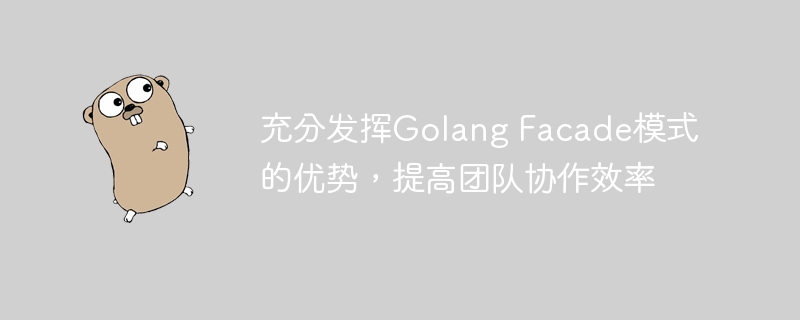Home >Backend Development >Golang >Give full play to the advantages of Golang Facade model and improve team collaboration efficiency
Give full play to the advantages of Golang Facade model and improve team collaboration efficiency
- 王林Original
- 2023-09-27 16:30:491108browse

To take full advantage of the Golang Facade model and improve team collaboration efficiency, specific code examples are required
Introduction:
As the complexity of software development projects continues to increase , teamwork becomes particularly important. In modern software development, using design patterns to improve team collaboration and code reuse has become a common practice. This article will introduce the advantages of the Golang Facade mode, and use specific code examples to show how to give full play to the advantages of this mode to improve team collaboration efficiency.
- Introduction to Golang Facade pattern
Golang Facade pattern is a structural design pattern that provides a simple interface for complex subsystems to facilitate interaction with clients. By using the appearance pattern, we can hide the complexity of the system behind a simple interface, thereby reducing the coupling between systems and improving the maintainability and reusability of the code. - Code Example
To better understand the advantages of the Golang Facade pattern, we will demonstrate it through an example of an online shopping system. In this shopping system, we have the following subsystems: user management, product management and order management. Each subsystem has its own interface and implementation.
First, we define a Facede interface, which will define the overall functionality of the system. In our example, we will use the following methods: login, add items to cart, and place an order.
type Facede interface {
Login(username, password string) bool
AddToCart(userID int, productID int) bool
PlaceOrder(userID int) bool
}Next, we implement the Facede interface. In this implementation, we need to introduce subsystems for user management, product management, and order management.
type OnlineShoppingFacede struct {
userManager UserManager
productManager ProductManager
orderManager OrderManager
}
func NewOnlineShoppingFacede() *OnlineShoppingFacede {
return &OnlineShoppingFacede{
userManager: NewUserManager(),
productManager: NewProductManager(),
orderManager: NewOrderManager(),
}
}
func (f *OnlineShoppingFacede) Login(username, password string) bool {
return f.userManager.Login(username, password)
}
func (f *OnlineShoppingFacede) AddToCart(userID int, productID int) bool {
return f.productManager.AddToCart(userID, productID)
}
func (f *OnlineShoppingFacede) PlaceOrder(userID int) bool {
return f.orderManager.PlaceOrder(userID)
}In the above example, we created an OnlineShoppingFacede structure and implemented all methods of the Facede interface. In the implementation of each method, we delegate specific functions to the corresponding subsystem, thereby achieving the purpose of reducing the coupling between systems.
Finally, let’s take a look at how to use the Facede interface and take full advantage of the Golang Facade pattern.
func main() {
onlineShoppingFacede := NewOnlineShoppingFacede()
loggedIn := onlineShoppingFacede.Login("username", "password")
if loggedIn {
addToCart := onlineShoppingFacede.AddToCart(1, 1)
if addToCart {
placeOrder := onlineShoppingFacede.PlaceOrder(1)
if placeOrder {
fmt.Println("Order placed successfully.")
} else {
fmt.Println("Failed to place order.")
}
} else {
fmt.Println("Failed to add product to cart.")
}
} else {
fmt.Println("Failed to login.")
}
}In the above example, we first instantiate the OnlineShoppingFacede and use the methods it provides to log in, add items to the shopping cart and place orders. By using the Facede interface, we can easily call the functions of the subsystem without paying attention to the specific implementation details of the subsystem.
By using the Golang Facade pattern, we can hide the complexity of the system behind a simple interface, thereby improving team collaboration efficiency. Team members only need to pay attention to the methods provided by the Facede interface and do not need to pay attention to the implementation details of the subsystem. This allows team members to focus more on their work and be better able to work together.
Conclusion:
In this article, we introduced the advantages of the Golang Facade pattern through specific code examples, and showed how to give full play to the advantages of this pattern to improve team collaboration efficiency. By using the Facede interface and specific implementation, we can hide the complexity of the system behind a simple interface, reduce the coupling between systems, and improve the maintainability and reusability of the code.
By giving full play to the advantages of the Golang Facade model, team members can focus more on their work and be better able to divide labor and cooperate. This will greatly improve team collaboration efficiency and promote the successful completion of projects. Therefore, in actual software development, we should actively use the Golang Facade pattern to improve team collaboration efficiency.
The above is the detailed content of Give full play to the advantages of Golang Facade model and improve team collaboration efficiency. For more information, please follow other related articles on the PHP Chinese website!
Related articles
See more- Detailed examples of the differences between Facade mode and Mediator mode in JavaScript design
- How to determine whether map exists in golang
- How to determine whether a golang structure is empty
- What is the mascot of golang?
- A powerful tool to improve team collaboration efficiency: PHP Hyperf microservice development experience sharing

